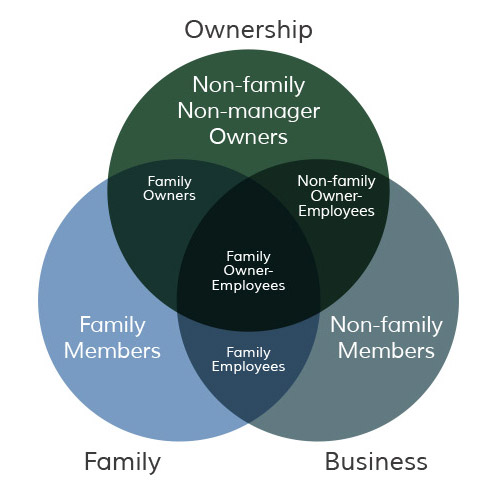A family business is no easy feat.
Disagreements – that naturally happen in most families – can quickly escalate, crippling business relationships. For example, it could be a mere disagreement over business operations. However, it is enough to impact the overall performance of the entire organisation.

Fortunately, a framework has been developed to specifically address the issue of internal family conflicts impacting family-run firms. It’s called the 3 circle model of family business.
Learning and applying the basics of governance in a family business, such as this model, and passing it down from generation to generation is immensely beneficial for creating a family and a business legacy.
Read on to find out how!
Table of Contents
The Central Organizing Framework for Family Firms: The 3 Circle Model of Family Business
The 3 circle model for family business was designed in 1978 by Renato Tagiuri and John Davis on the grounds of the Harvard Business School campus.
Essentially, the system classifies, in simple and graphic terms, the three interdependent and overlapping groups that make up the family business system: the family, the business, and ownership. Due to the overlap, there are seven interest groups which have their own legitimate viewpoints, aims, and dynamics.
As per John A. Davis and Taguiri, the long-term sustainability of family business systems depends on how effectively these groups function and support each other.
This 40-year-old model was rapidly adopted by family-run firms, consultants, and academics around the world. It continues to be the most central organising framework used to analyse and study family businesses.
The 3 Circles and the 7 Interest Groups
The definition of a family company is one where ownership is controlled by a single family. The 3 circle model of family business has three main components, each representing an aspect of family business – the family, business, and ownership.

Each circle goes through its phases of growth, and each member will be at a different stage of development. Since the circles are either dependent, independent or a result of other circles, there is often strong commitment without proper communication.
The 3 circle model of family business is to prevent such business system issues and other business challenges.
Circle 1: The Family
The heart of the business organisation lies in the family circle, where fostering and maintaining familial ties are crucial.
Encapsulating the interpersonal relationships of family firms, this circle highlights the nature of family dynamics in communication, decision-making, and resolving issues within a business landscape. This circle comprises matters such as sibling conflict, conversations on succession, and implementing the family’s values into business practices.

Regular business meetings to clarify and miscommunication are paramount to business-family relationships. These meetings can be held to acknowledge concerns candidly and ensure that everybody is heard, keeping in mind that multiple viewpoints must be integrated to create an effective future direction for business goals.
Moreover, establishing clear boundaries between family life and business is necessary to avoid disagreements and maintain family relationships.
YOU MIGHT BE INTERESTED IN: Identity and Belonging: Reflections on Heritage with Haroon Sacranie
Circle 2: The Business
The second circle is centred around the operational facets of the business organisation. The business circle is quite flexible since it can represent either one business, multiple businesses, holding companies or even joint ventures.
Here, a strong focus is placed on performance, competitiveness, and strategy. It also talks about topics such as market dynamics and invention.
Family businesses often stumble with the need for professional management to ensure long-term business sustenance.
Hence, this circle suggests having a strong management team for good business management. It is essential to specify clear aims, strategies, and effective governance structures.
Circle 3: Ownership
The ownership circle talks about the business ownership structure and financial areas of the family firm to avoid business-family-ownership tensions. This is related to matters such as the distribution of equity, ownership agreements, and finance management.
Family members often tend to have differing views on dividends and reinvestment during such processes.
Having clear ownership structures through shareholder agreements and proper succession plans is crucial. Ownership interests should be designed in accordance with the long-term goal of the business, which is to ensure that all company members are working towards a unified cause and that everyone has the same sense of direction.
The 7 Interest Groups
The overlapping of the three circles leads to seven interest groups. All individuals in the family business, including new definitions of family, such as in-laws, divorced couples, adopted children, and domestic partners, are all family members.
They are:
- Family members who are owners but do not work in the business.
- Family members who are owners and who work in the business.
- Family members who work in the business but are not owners (bottom-centre sector).
- Non-family members who are owners but do not work in the business.
- Non-family members who are owners and work in the business.
- Non-family members who work in the business.
Being a part of two interest groups will be considered as being in an overlapping sector.
Benefits of the 3 Circle Model of Family Business
The 3 Circle Business Model provides numerous benefits for the family business community. Confusion and conflict can be significantly reduced by having clear boundaries with open communication and collaboration between the three circles.

Family members and professionals can work together to make good decisions that match both family interests and business requirements. Many people have reported that relationship tensions were clearer once they figured out where their relatives stood in the 3 circle model of family business. Additionally, the model assists researchers in conducting a deep analysis of family businesses.
Moreover, the 3 circle model of family businesses is a solid reminder that each circle’s standpoints and its members often differ in meaningful ways. Each viewpoint should be respected, given equal consideration, and implemented in unique ways while keeping in mind the interests of the business.
When familial relationships are strong, there is higher enthusiasm to cooperate and work towards the desired goals. This results in collective responsibility, which plays a central role in the success of the family business and its long-term growth.
Steps to Implementing the 3 Circle Model to Family Business Systems
Practically implementing a three-circle perspective to avoid conflicts and maintain stability requires a thoughtful approach to governance. Below are a few steps to get you started!
1. Holding family meetings: Meetings held specifically for family relationship issues go a long way to improving relationships. It is essential to keep in mind that these should be separated from business plans. All members should take special care to ensure that business life disagreements at the conference table are not carried into family life.
2. Clear Governance Structures: Setting proper governance structures that are mutually agreed upon with clear roles and responsibilities assigned to each member is essential. This is to avoid potential role confusion and ensure that everybody knows their place within the business organisation.
3. Advisory Board: Family businesses can consider establishing a board of advisors of experienced professionals who offer guidance based on the governance maturity of each circle. The board could comprise both family and non-family members, such as business advisors or a private equity partner with knowledge of family-owned businesses aimed at supervising business owners and shareholders.
Conclusion
While family businesses are constantly faced with challenges, the 3 circle model is a valuable tool to adopt to navigate conflicts and achieve long-term success. It has been paramount in helping researchers and business owners understand and manage issues in past and current family business systems.
By building strong familial relationships with the circles, setting clear boundaries, and having commitment, communication and respect, the 3 circle model of family business can sustain a business for decades to come.
FAQs
What is the 3 circle model of the family business?
The 3 circle model of family business was designed in 1978 by Renato Tagiuri and John Davis on the grounds of the Harvard Business School campus.
Essentially, the system classifies, in simple and graphic terms, the three interdependent and overlapping groups that make up the family business system: the family, the business, and ownership.
What is a family business system?
A family business system is a type of business organisation owned and handled by two or more family members.
What is the 3 circle model of business dynamics?
The 3 circle model of family business clarifies the distinct yet interconnected groups in a family business – the family, the business, and ownership.










[…] Harvard Business School professors and students developed the 3-circle model of family business conflict resolution to resolve any discord among family members and also provides a framework for organising family […]